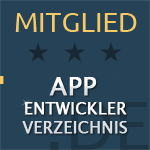Effective code documentation is crucial for Flutter projects. It not only enables better collaboration within the team but also supports long-term maintainability and scalability of the code. In this context, the use of Git repositories plays a central role, as it allows for structured version control, thus laying the foundation for efficient code documentation.
So why do we, as Flutter developers, rely on Git for version control and place particular importance on meaningful commits?
The benefits of Git for Flutter developers are manifold. Git enables a transparent and collaborative working style by allowing developers to work on different features in parallel and manage and synchronize their changes easily. By using branches, different development strands can be kept cleanly separated, greatly improving the organization and traceability of the code.
Meaningful commits are an essential part of this process. They serve not only to document individual code changes but also contribute significantly to the traceability and comprehensibility of the code. By clearly and concisely formulating their commits and providing a detailed description of their adjustments in English, developers create valuable documentation of the development process. This documentation is important not only for the current development team but also for future developers who need to understand and further develop the code.
The use of Git and meaningful commits also has direct implications for code documentation and project transparency. By structuring the storage of commits in the Git repository, a comprehensive history of the project is created, allowing project managers and agency owners to track the project's progress and make informed decisions.
In the following sections, we will discuss how we, as Flutter developers, create meaningful branches, utilize many small commits, and create a clear overview when making a pull request, resembling documentation.
Structured Branches for Efficient Development in Flutter Projects
A structured branch management is important for efficient development in Flutter projects. It enables an orderly and clear organization of the code, both for individual developers and for the entire development team.
Meaningful Branch Naming and Management
Choosing appropriate branch names is the first step toward structured branch management. Branch names should be informative and meaningful to give developers a clear idea of what changes are made in a particular branch. For example, branch names like "feature/login-screen", "bugfix/user-registration", or "hotfix/crash-fix" could be used to describe the type of work being done.
Managing these branches should also be organized. This can be done by establishing clear guidelines and processes for creating, merging, and deleting branches. For instance, developers might be instructed to create a separate branch for each new feature or issue to ensure a clean separation of changes.
Building a Clearly Structured Branch Architecture
To improve the clarity and traceability of the code, it is advisable to define a clearly structured branch architecture for different phases of development. This could mean, for example, using separate branches for developing new features, fixing bugs, and implementing hotfixes. Adhering to this structure ensures that changes can be made in an orderly and targeted manner without compromising the stability of the main code.
Tips for Effectively Using Feature Branches, Bugfix Branches, etc.
When utilizing different types of branches, it is important to keep in mind some best practices. Feature branches, for example, should be regularly merged with the main development branch to avoid conflicts and facilitate continuous integration. Bugfix branches should also be processed and tested promptly to ensure quick resolution of issues. Additionally, it is advisable to maintain clear documentation of changes made for each branch to facilitate traceability and collaboration within the team.
Small Commits for Better Understandability in Flutter Development
Small, granular commits are an essential part of effective code documentation and version control in Flutter projects. They not only enable precise traceability of changes in the code but also improve collaboration within the team and simplify code review.
The Importance of Small, Granular Commits for Code Traceability
Small commits are like building blocks that allow developers to trace the development process step by step. Instead of capturing large changes all at once, developers should break their work into small, discrete units and capture these as separate commits. This makes the history of the code clearly and understandably documented, benefiting both developers and project managers and agency owners.
Practical Tips for Splitting Changes into Small Commits
There are various approaches to splitting changes into small commits. One possibility is to document each logical unit of change as a separate commit. This could involve adding a new feature, fixing a bug, or refactoring code. By focusing on a single task per commit, readability and understandability of the code improves.
Another practical tip is to regularly review one's code during the development process. By splitting changes into smaller steps, it becomes easier to keep track of one's progress and ensure that each change is carefully documented and reviewed before it is captured.
How Small Commits Improve Team Collaboration and Code Review
Small commits also facilitate collaboration within the team and code review. By documenting their changes in small, manageable units, it becomes easier for other team members to understand and respond to one's code. Furthermore, the granular division of changes allows for efficient code review, as individual commits can be reviewed and commented on more easily.
English Commit Messages as Part of Documentation in Flutter Projects
English commit messages play an essential role in the documentation of code changes in Git repositories. They help ensure a consistent and comprehensible documentation of the development process and enable developers to trace the changes made.
The Role of English Commit Messages for Consistent and Understandable Documentation
English commit messages serve as the key to consistent and understandable documentation of the development process. By documenting their changes in English, developers create a common language that is understood by all team members. This improves traceability and collaboration within the team, as every developer is able to understand and respond to the changes made.
Best Practices for Writing Meaningful Commit Messages
When writing commit messages, it is important to observe some best practices to ensure meaningful documentation. This includes using a concise and informative message format that clearly describes the purpose of the change. A good commit message should include a brief summary of the changes made and provide additional context information as necessary to better understand the code.
An example of a meaningful commit message could look like this: "Added user authentication feature (#123)". This message clearly describes what change was made (adding a user authentication feature) and even includes the associated ticket number in the project management tool.
Integration of Jira, Trello, or Other Project Management Tools for Better Contextualization
The integration of project management tools like Jira, Trello, or other similar tools can further improve the contextualization of commit messages. By linking commits to associated tickets or tasks within these tools, it ensures that commit messages always reflect the current context of the development project. This enables developers to better document their changes and makes it easier for project managers and agency owners to trace the development progress.
The Pull Request as the Final Documentation Overview in Flutter Development Projects
The pull request marks the completion of a development cycle and is a pivotal phase to ensure comprehensive code documentation. A clean and detailed pull request not only provides an overview of the changes made but also serves as the final source of documentation for a development step.
The Importance of a Clean and Detailed Pull Request
A clean and detailed pull request is essential for traceability and quality assurance in the development process. It not only serves to transparently document the changes made but also enables other team members to efficiently review the code and provide feedback. Furthermore, the pull request forms an important basis for project management, as it clearly represents the current state of the code, along with open tasks and issues.
Structuring a Pull Request to Provide Comprehensive Code Documentation
To ensure comprehensive code documentation, a pull request should be structured and organized. This can be achieved by using clear sections and subdivisions that address various aspects of the changes. Typical sections of a pull request might include a summary of the changes, a list of affected files, a description of tests conducted, and a list of open tasks or questions.
The quality of a pull request description has direct implications for project management, as it provides project managers and agency owners with a clear overview of development progress and open issues. A complete and precise pull request description allows project managers to respond quickly and effectively to changes, set priorities, and allocate resources to ensure the project progresses successfully.
Conclusion
The effective use of Git and meaningful commits is crucial for code documentation and collaboration in Flutter development projects. Through the structured use of branches and the division of changes into small, granular commits, developers create a transparent and traceable history of their code, enabling clear documentation and understanding of the development process.
The importance of continuous improvement and adaptation of development practices should not be underestimated. By regularly reviewing and optimizing their working methods, developers can ensure that they remain up to date with best practices and continuously enhance their efficiency and productivity.
Overall, the use of Git and meaningful commits, as well as the ongoing improvement of development practices, ensures that Flutter developers can create comprehensive and understandable documentation of their code, laying the foundation for successful and sustainable development projects.
Do you want to successfully and sustainably implement your Flutter project? Then let’s work together! With my expertise in Flutter development with Git, meaningful branch structuring, and detailed commits, I am ready to assist you with your project.
All insights
All insights
“Flutter and the related logo are trademarks of Google LLC. We are not endorsed by or affiliated with Google LLC.”
“Flutter and the related logo are trademarks of Google LLC. We are not endorsed by or affiliated with Google LLC.”
Copyright ©2025. Julian Giesen. All rights reserved.
“Flutter and the related logo are trademarks of Google LLC. We are not endorsed by or affiliated with Google LLC.”








